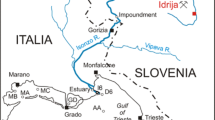Abstract
Much of the toxic methylmercury (MeHg) that biomagnifies in the aquatic food chain and accumulates in fish and seafood is believed to originate from microbial methylation of inorganic Hg+2 in anoxic sediments. We examined the effect amending wetland sediments with activated carbon and biochar on Hg methylation potentials using microcosms and Hg stable isotope tracers. The inorganic 200Hg+2 spike was methylated at ~0.37 %/day in the untreated sediment, but that rate decreased to <0.08 %/day for the amended sediments, with 80 % and 88 % reductions in methylation rates for activated carbon and biochar amendments, respectively. Demethylation rates were relatively unchanged. Our key finding is that amending contaminated sediment with activated carbon and biochar decreases bioavailable Hg, and thus may also decrease Hg transfer into food webs. However, further research is needed to evaluate exactly how the sorbents impact Hg methylation rates and for related field studies.

Similar content being viewed by others
References
Ahmad M, Rajapaksha AU, Lim JE, Zhang M, Bolan N, Mohan D, Vithanage M, Lee SS, Ok YS (2014) Biochar as a sorbent for contaminant management in soil and water: a review. Chemosphere 99:19–33
Bussan DD, Sessums R, Cizdziel JV (2015) Direct mercury analysis in environmental solids by ICP-MS with on-line sample ashing and mercury pre-concentration using a direct mercury analyzer. J Anal At Spectrom 30:1668–1672
Clarkson TW, Fitzgerald WF (1991) Mercury and monomethylmercury: present and future concerns. Environ Health Perspect 96:159–166
Compeau G, Bartha R (1985) Sulfate-reducing bacteria: principal methylators of mercury in anoxic estuarine sediment. Appl Environ Microbiol 50:498–502
Driscoll CT, Mason RP, Chan HM, Jacob DJ, Pirrone N (2013) Mercury as a global pollutant: sources, pathways, and effects. Environ Sci Technol 47:4967–4983
Ghosh U, Luthy RG, Gillette JS, Zare RN (2000) Microscale location, characterization, and association of polycyclic aromatic hydrocarbons on harbor sediment particles. Environ Sci Technol 34:1729–1736
Ghosh U, Luthy RG, Cornelissen G, Werner D, Menzie CA (2011) In-situ sorbent amendments: a new direction in contaminated sediment management. Environ Sci Technol 45:1163–1168
Gilmour CC, Riedel GS, Riedel G, Kwon S, Landis R, Brown SS, Menzie CA, Ghosh U (2013) Activated carbon mitigates mercury and methylmercury bioavailability in contaminated sediments. Environ Sci Technol 47:13001–13010
Gomez-Eyles JL, Yupanqui C, Beckingham B, Riedel G, Gilmour C, Ghosh U (2013) Evaluation of biochars and activated carbons for in situ remediation of sediments impacted with organics, mercury, and methylmercury. Environ Sci Technol 47:13721–13729
Heyes A, Miller C, Mason RP (2004) Mercury and methylmercury in Hudson River sediment: impact of tidal resuspension on partitioning and methylation. Mar Chem 90:75–89
Heyes A, Mason RP, Kim EH, Sunderland E (2006) Mercury methylation in estuaries: insights from measuring rates using mercury stable isotopes. Mar Chem 102:134–147
Hintelmann H, Evans R (1997) Application of stable isotopes in environmental tracer studies—measurement of monomethylmercury (CH3Hg+) by isotope dilution ICP-MS and detection of species transformation. Fresenius J Anal Chem 358:378–385
Hintelmann H, Keppel-Jones K, Evans RD (2000) Constants of mercury methylation and demethylation rates in sediments and comparison of tracer and ambient mercury availability. Environ Toxicol Chem 19:2204–2211
Kuzyakov Y, Subbotina I, Chen H, Bogomolova I, Xu X (2009) Black carbon decomposition and incorporation into soil microbial biomass estimated by 14C labeling. Soil Biol Biochem 41:210–219
Marsh H, Reinoso FR (2006) Activated carbon. Elsevier, San Diego
Martín-Doimeadios RC, Stoichev T, Krupp E, Amouroux D, Holeman M, Donard O (2002) Micro-scale preparation and characterization of isotopically enriched monomethylmercury. Appl Organomet Chem 16:610–615
Martín-Doimeadios RC, Tessier E, Amouroux D, Guyoneaud R, Duran R, Caumette P, Donard OFX (2004) Mercury methylation/demethylation and volatilization pathways in estuarine sediment slurries using species-specific enriched stable isotopes. Marine Chem 90:107–123
Pickhardt PC, Fisher NS (2007) Accumulation of inorganic and methylmercury by freshwater phytoplankton in two contrasting water bodies. Environ Sci Technol 41:125–131
Prestbo EM, Gay DA (2009) Wet deposition of mercury in the U.S. and Canada, 1996–2005: results and analysis of the NADP mercury deposition network (MDN). Atmos Environ 43:4223–4233
Schartup AT, Mason RP, Balcom PH, Hollweg TA, Chen CY (2013) Methyl-mercury production in estuarine sediments: role of organic matter. Environ Sci Technol 47:695–700
Selin NE (2009) Global biogeochemical cycling of mercury: a review. Annu Rev Environ Resour 34:43–63
Sunderland EM (2007) Mercury exposure from domestic and imported esuarine and marine fish in the U.S. seafood market. Environ Health Perspect 115:235–242
Uchimiya M, Klasson KT, Wartelle LH, Lima IM (2011) Influence of soil properties on heavy metal sequestration by biochar amendment: 1. Copper sorption isotherms and the release of cations. Chemosphere 82:1431–1437
Zahir F, Rizwi SJ, Haq SK, Khan RH (2005) Low dose mercury toxicity and human health. Environ Toxicol Pharmacol 20:351–360
Zhang L, Wright LP, Pierrette B (2009) A review of current knowledge concerning dry deposition of atmospheric mercury. Atmos Environ 43:5853–5864
Zimmerman AR, Gao B, Ahn M-Y (2011) Positive and negative carbon mineralization priming effects among a variety of biochar-amended soils. Soil Biol Biochem 43:1169–1179
Acknowledgments
We are grateful to the University of Mississippi’s Sally McDonnell Barksdale Honors College and the Department of Chemistry and Biochemistry for financial support for this research. We thank Robert Mason, Prentiss Balcom and Nashaat Mazrui at the University of Connecticut for demonstrating experimental procedures to determine Hg methylation rates in sediments. The biochar was provided by Todd Mlsna at Mississippi State University.
Author information
Authors and Affiliations
Corresponding author
Rights and permissions
About this article
Cite this article
Bussan, D.D., Sessums, R.F. & Cizdziel, J.V. Activated Carbon and Biochar Reduce Mercury Methylation Potentials in Aquatic Sediments. Bull Environ Contam Toxicol 96, 536–539 (2016). https://doi.org/10.1007/s00128-016-1734-6
Received:
Accepted:
Published:
Issue Date:
DOI: https://doi.org/10.1007/s00128-016-1734-6




